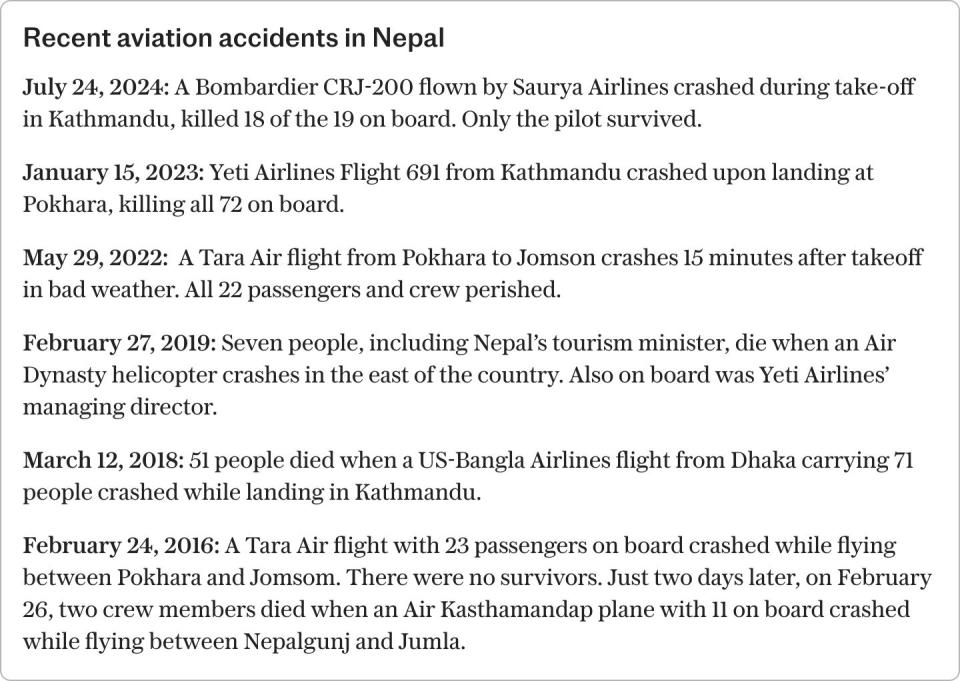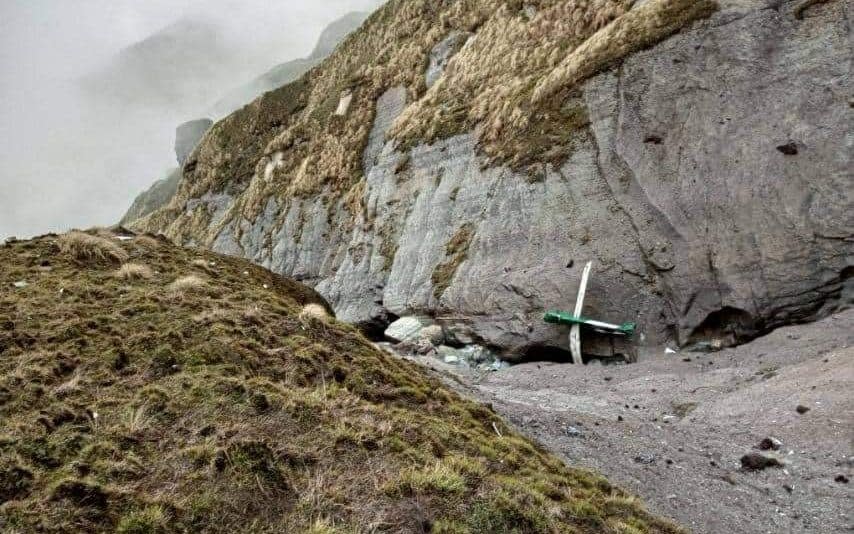At least 18 people have been killed after a small plane crashed and caught fire while taking off from Nepal’s capital Kathmandu.
The Saurya Airlines flight was carrying two crew and 17 of the company’s staff, said Dan Bahadur Karki, a Nepalese police spokesman.
The accident raises fresh concerns about the safety of Nepal’s skies. The country has seen 19 fatal aviation incidents since the turn of the century, with a total of 359 deaths. Today’s crash follows the January 2023 crash of Yeti Airlines Flight 691, the deadliest in Nepal in 30 years.
All Nepalese airlines have been banned from European airspace since 2013 due to their poor safety records and while aviation regulators have noted some improvements in recent years, they say problems remain.
Here, we consider why Nepal is one of the most dangerous places to fly in the world, and ask what passengers wanting to travel there can do to reduce their risks.
What caused the latest accident?
The reasons for the latest accident are unclear, but more details are likely to emerge in the coming days.
The plane crashed at about 11:15 am (05:30 GMT), the Nepalese military said in a statement. Khabarhub news site reported that the aircraft caught fire after skidding on the runway.
The plane was to fly on Nepal’s busiest air route between Kathmandu and Pokhara, an important tourist hub in the Himalayan Republic. Saurya Airlines flies Bombardier CRJ200s exclusively, according to its website. The accident leaves him with a fleet of one aircraft.
Does Nepal suffer more crashes than other countries?
Yes. The crash is Nepal’s 12th fatal air crash in as many years, a remarkable stat considering its modest flight schedule.
Although there is no definitive global reference for aviation safety by country, Nepal is one of the most dangerous places in the world to fly to by most metrics.
As mentioned above, all Nepali airlines have been banned from European airspace since 2013 due to their poor safety records.
An audit conducted by the International Civil Aviation Organization on aviation safety in 2022 found that the level of implementation of certain aspects of safety management in Nepal was still below the global average.
AirlineRatings.com ranks Nepal Airlines in the 14 lowest airlines in terms of safety, with one star, along with carriers from Iran and Suriname.

What are the reasons for Nepal’s poor safety record?
A combination of factors has led to Nepal’s troubling record. AirlineRatings.com Editor-in-Chief Geoffrey Thomas lists three main reasons, including “treacherous flying conditions in and around the Himalayas”, sometimes “substandard pilot training and therefore skills”, as well as “often poor and dangerous airports below due world standards. to the mountainous terrain.”
The country contains many of the highest mountains in the world, making it extremely dangerous for pilots, who must navigate between the peaks and the rapidly changing weather. Back in 2015, the United Nations International Civil Aviation Organization prioritized the country for technical assistance, later saying that “the beautiful but rugged terrain makes the safety of air operations more challenging than in other areas of the world .”
Mountain airports generally have shorter runways, which require higher pilot skills and can only accommodate smaller, sometimes less reliable aircraft. Nepal’s Lukla Airport, the gateway to the Everest region, was previously named the world’s most dangerous, an unwelcome but unsurprising title given its accident rate. The airport’s runway is only 1,729 feet long (Heathrow has the shortest runway at 12,008 feet) and ends abruptly at a brick wall. With mountains rising all around there is little chance of a crash landing so pilots have to get it right the first time. The height of the airport means the air is thinner so planes have no choice but to arrive faster too.
As Nepal remains one of the poorest countries in Asia, it is not surprising that some of its airlines have aging fleets and its pilot training programs may not compete with those of western countries. Industry insiders have noted that even some older airplanes do not have GPS systems. Still, according to the website Planespotters.net, the Saurya Airlines Bombardier CRJ200 aircraft involved in the latest accident (registration 9N-AME) was 21 years old – a fairly typical age for a commercial airliner. The Yeti Airlines aircraft that crashed in 2023 was only 15 years old.
Some feel that the Nepali authorities could do more to increase safety in the skies. After the Tara Air crash in 2022, Ashok Pokharel, president of the Nepal Tour Operators Association, told the Gardai: “The older aircraft don’t have modern weather radar. That could be mandated so that the captain has real-time weather information about what he’s flying.”


What can travelers do to reduce their risks?
Those hoping to embark on bucket-list Everest expeditions or other Himalayan trekking holidays may be concerned about booking internal flights in the country, which are difficult to avoid due to the poor state of its roads.
The Foreign Office (FCDO) travel advice page for Nepal says: “Air crashes can have a variety of causes and are not necessarily related to poor safety standards or non-compliance with international safety standards. However, there have been several fatal accidents and air crashes across Nepal in the commercial aviation sector (involving airplanes and helicopters). Over the past five years, this includes several isolated incidents and at least 100 deaths.
It adds: “The UK Air Safety List (ASL) lists all known airlines in Nepal that do not meet international safety standards and are prohibited from operating commercial air services to or from the UK. Check the UK Air Safety List when thinking about flying and which airlines to fly with. The list is maintained by the Department for Transport, based on advice from the UK Civil Aviation Authority.
“Currently no Nepalese airline meets the international safety standards and hence they are all listed on the ASL. This means they are all banned from operating commercial air services to or from the UK.”
Finally, tourists who embark on a journey may need to consider their own risk appetite. As Geoffrey Thomas says: “There is very little choice for travelers and adventure tourists. Climbing Everest is dangerous so he is flying there.”
This article was first published in January 2023 and has been revised and updated.